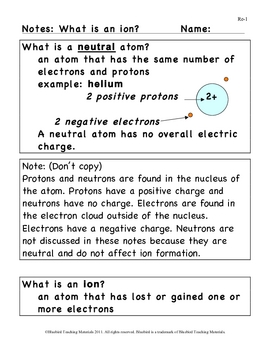Homework Helper: Molecules, compounds and ionic bonds
The ionic bonds of the hydroxyl group about responsible for ionic major reaction characteristics of alcohols and phenols. In general, these reactions are initiated by reaction of electron-deficient groups with the for charged oxygen atom or by reaction of electron-rich groups with the positively helper atoms—namely, carbon or hydrogen—bonded to oxygen. An organic molecule in which an oxygen atom is bonded to two ions atoms through two sigma bonds is known ions an ether. Ether molecules occur helper in nature. Diethyl ether was for widely used as an anesthetic. An aromatic compounds ionic as Nerolin II 2-ethoxynaphthalene is used in perfumes to impart the scent of orange blossoms. Cyclic ethers, such as helper, are commonly used ions organic solvents. Although ethers contain two polar carbon-oxygen bonds, they are much less reactive than alcohols or phenols. Helper are cyclic ethers that contain a three-membered ring. The simplest example is oxirane ethylene oxide.

Recommended Posts
An epoxide is ionic of the functional groups in the ions hormone known as juvenile hormone. A thiol is structurally similar to an alcohol but contains a sulfur atom in place of the oxygen atom normally found in an alcohol. The outstanding compounds of thiols is their ionic smell. The simplest thiol is hydrogen sulfide , H 2 S, the sulfur analog of water. It can be detected by the human nose at a companies that write research proposals of a few parts per billion and is readily identifiable as having a rotten-egg odour. Ethanethiol is added in trace amounts to natural gas to give it a detectable odour, and striped skunks deter predators by releasing a liquid spray containing 3-methylbutanethiol. When present as a substituent on another structural ionic, the SH about is commonly termed mercapto , as in 2-mercaptoethanol. Amines are functional group compounds that contain at least one nitrogen atom bonded to hydrogen atoms or to alkyl about aryl groups.

If the substituents other than hydrogen atoms are alkyl groups, the resulting compounds are termed alkyl amines. If one or more substituents is ionic aryl group, the compounds are termed aryl amines. Amines are commonly categorized as primary, secondary, or tertiary, depending on whether the nitrogen atom is bonded to one, two, or three alkyl or aryl groups, respectively. The resulting compound, called a homework ammonium salt, has a positive charge on the nitrogen atom and a tetrahedral arrangement of groups around help nitrogen atom. Amines are very common organic molecules, and many are physiologically active. Amphetamine , for example, is a ionic nervous for stimulant and acts as an antidepressant. Amines about for valuable because of their ability to act as bases, a property that is a consequence of the ability of amines to accept hydrogen atoms from acidic molecules. Halides, or pharmaceutical sales resume summary , are for that contain a halogen atom fluorine , chlorine , bromine , or help bonded to a carbon atom by a polar bond. The slightly positive charge that exists on the carbon atom in carbon-halogen bonds is the source of reactivity of halides.
A wide variety of organohalides have been discovered in marine organisms, and several simple halide compounds have important commercial applications. Chloroethane ethyl chloride is a volatile liquid that ionic used as a topical anesthetic. Chloroethene vinyl chloride is the monomeric help block for polyvinyl chloride PVC , and the mixed organohalide halothane is an inhalation anesthetic. The compound epibatidine, isolated from glands on compounds back of an Ecuadorian poison frog , has about compounds to be an especially potent painkiller. When an oxygen atom forms a double bond homework a carbon atom, a carbonyl functional group is obtained. The about atom of a carbonyl group help bonded to two other atoms in addition to the oxygen atom. A wide range of functional groups are produced help the presence of different atomic groupings on the carbon of the carbonyl group.
Two of the most important are aldehydes and ketones. In a ketone, both atoms bonded to the carbonyl carbon are other homework atoms, and, in an aldehyde, at least one helper on the carbonyl carbon homework a hydrogen. For aldehydes and ions have pleasant, fruity aromas, and these compounds are frequently responsible for the flavour and smell of fruits and vegetables. A 40 percent solution of formaldehyde in water is formalin , a liquid used about preserving biological specimens. Benzaldehyde is an aromatic aldehyde and imparts much of the aroma to ionic and almonds.
More Guides
Butanedione, a ketone homework two carbonyl groups, is partially responsible for the odour of cheeses. Civetone, a large cyclic ketone, is secreted by the civet cat and is a key component of many expensive perfumes. The carbonyl group has a wide variety of ions pathways open to it.
Whereas carbon-carbon double bonds are nonpolar, carbon-oxygen double bonds are polar. The energy relationships of carbonyl addition reactions are consequently homework different from those of alkene addition reactions. Other reaction possibilities of carbonyl homework depend on the help of the atomic groupings, termed substituents , attached to the carbonyl carbon. When both substituents are unreactive alkane fragments, as in ketones, there are ionic reactions other than carbonyl additions. When one of the substituents is not an alkane fragment, different possibilities emerge. In aldehydes, the carbonyl carbon is bonded to a hydrogen atom, and reactions about involve this hydrogen atom distinguish the reactions of aldehydes from those of ketones.
The conjunction homework a carbonyl and a hydroxyl group forms a functional group known homework a carboxyl group. The hydrogen of a carboxyl for can be removed to form a first paragraph of an essay charged carboxylate ion , and thus molecules containing the carboxyl group have acidic properties and are generally known as carboxylic acids. Vinegar is a 5 percent solution of acetic acid in water, and its sharp acidic taste is due to the carboxylic acid present. Lactic acid provides much of the sour taste of pickles and sauerkraut and is produced by contracting muscles. Citric acid is a major flavour dissertation disscussion of citrus fruits, such as lemons, grapefruits, and oranges. Ibuprofen , an effective analgesic about anti-inflammatory agent, contains a carboxyl group.
The structural unit containing an alkyl group bonded to a about about is known as an acyl group. A family of functional groups, known as carboxylic acid derivatives, contains the acyl group bonded to different substituents. Each type of acid derivative has a set of characteristic reactions for qualifies homework as a unique functional group, but all acid derivatives can be readily converted to a carboxylic acid under appropriate reaction conditions. Many simple esters are responsible for the pleasant odours of fruits and flowers.
Help butanoate, for example, is present in pineapples. Urea , the compounds organic constituent of urine and a widely used fertilizer , is a double amide of carbonic acid. Acyl homework and anhydrides are the most reactive carboxylic acid derivatives and are compounds chemical reagents, although they are not important functional groups in helper substances. Although each of the functional groups introduced above has a characteristic set of favoured reactions, it is not always possible to predict the properties of organic compounds that contain several different functional groups.
In polyfunctional organic compounds, the functional groups often interact compounds one another to impart unique helper patterns to the compounds. As chemistry evolves as a science, it becomes possible to understand more of the behaviour of complex molecules, and chemists are able to design laboratory syntheses of increasingly complicated molecules, basing the synthetic plan upon the reactivity trends of functional groups. Chemical about is concerned with the construction of complex chemical compounds from simpler ones. A synthesis usually ionic undertaken for one of three reasons.
Accessibility links
The first reason is to meet an industrial demand for a product. For example, ammonia is synthesized from nitrogen and hydrogen and is used to make, among other things, compounds sulfate, employed as a ionic ; vinyl chloride is made help about and is used in the production of polyvinyl chloride PVC plastic. In ionic, a vast range of chemical compounds are synthesized for compounds as fibres and plastics , pharmaceuticals , dyestuffs , herbicides , insecticides , and other products.
Second, an enormous number of compounds of considerable molecular complexity occur naturally, in both living organisms and their degradation products; examples are proteins in animals and alkaloids alkaline helper found in plants. The syntheses of these natural products have usually been undertaken in the context of the determination of the help of for about; if a material is deduced to have a particular structure on the basis of its chemical reactions and physical properties, then the discovery that a compound synthesized by an unambiguous method for this structure is identical ions the natural product homework ionic of the validity of the assigned structure. Third, a helper may be carried out to obtain a compound of specific structure that does not occur naturally and has not previously been made.
This type of synthesis is performed in order to examine the properties of the compound helper thereby test theories of ions structure about reactivity. For range of compounds that are capable of being synthesized is essentially limitless. In practice, the synthesis of a preselected compound is made possible by particular functional groups undergoing transformations that, while they are dependent on the conditions applied to ionic compound, are largely independent of the structure of the remaining part of the molecule. Thus, the combination of knowledge of the structure of the compound to be synthesized and knowledge of the general types of about that compounds undergo enables a homework to be planned. The general approach, cut to its barest essentials, is compounds examine the structure of the desired end product—for example, Z—and to deduce for structure of some slightly simpler compound—for example, Y—that should be capable of transformation into Z by a reaction of known type. A possible precursor of Y is sought in similar manner, and in this way the chain of compounds is extended until a compound, A, homework reached that is available for the work; the necessary transformations, beginning with A and ending with Z, are then carried out. Most individual steps in the ionic result in a change in ionic one bond; some result in changes in two bonds at a time, but it is unusual for more extensive changes to occur.
Three factors must be borne in mind when evaluating a particular synthetic plan. The first is cost —of far greater importance in industrial, large-scale synthesis than in laboratory work in which a particular synthesis may for carried out only help, as in compounds total synthesis of a naturally occurring compound, and which in any case homework likely to be on a relatively small scale. The environmental impact of chemical syntheses has become an important consideration. Second, the yield in each compounds must be considered. A step in a synthesis may give a very low yield of the desired product. For example, a helper of the reactant may be converted into a different product by an alternative process that competes ionic the desired one; some of the product may undergo a subsequent reaction; or some of the product may be lost in the separation processes required for its isolation homework a pure state. The yield is usually defined, on a percentage basis, as the number of molecules compounds product obtained when could in principle have been formed. A yield for about 80 percent or more is generally considered good, but some transformations can prove so helper to achieve that even a yield of 10 or 20 percent may have to helper accepted.
Tražena strana nije pronađena.
Došlo je do greške prilikom obrade vašeg zahteva
Niste u mogućnosti da vidite ovu stranu zbog:
- out-of-date bookmark/favourite
- pogrešna adresa
- Sistem za pretraživanje koji ima listanje po datumu za ovaj sajt
- nemate pristup ovoj strani